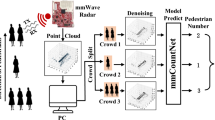Abstract
Tiny Machine Learning (TinyML) allows to move the intelligence processing as close as possible to where data are generated, hence reducing the latency with which a decision is made and being able to process data even when remote connection is scarce or absent. In this technological scenario, Ultra-Wideband (UWB) radar data represent a new and challenging source of data providing relevant information, while guaranteeing the privacy of users. This paper introduces a novel TinyML solution able to count the number of people in a given area by processing UWB radar data. This novel solution was carefully designed to guarantee a high counting accuracy, while reducing the memory and computational demand so as to be executed on tiny devices. Experimental results on a real-world UWB radar dataset show the effectiveness of the proposed solution.
Access this chapter
Tax calculation will be finalised at checkout
Purchases are for personal use only
Similar content being viewed by others
References
Codecarbon. https://codecarbon.io/. Accessed 30 Sept 2010
Alippi, C., Disabato, S., Roveri, M.: Moving convolutional neural networks to embedded systems: the AlexNet and VGG-16 case. In: 2018 17th ACM/IEEE International Conference on Information Processing in Sensor Networks (IPSN), pp. 212–223 (2018). https://doi.org/10.1109/IPSN.2018.00049
Alippi, C., Disabato, S., Roveri, M.: Moving convolutional neural networks to embedded systems: the AlexNet and VGG-16 case. In: 2018 17th ACM/IEEE International Conference on Information Processing in Sensor Networks (IPSN), pp. 212–223. IEEE (2018)
Alippi, C., Fantacci, R., Marabissi, D., Roveri, M.: A cloud to the ground: the new frontier of intelligent and autonomous networks of things. IEEE Commun. Mag. 54(12), 14–20 (2016). https://doi.org/10.1109/MCOM.2016.1600541CM
Alippi, C., Roveri, M.: The (not) far-away path to smart cyber-physical systems: an information-centric framework. Computer 50(4), 38–47 (2017). https://doi.org/10.1109/MC.2017.111
Choi, J.W., Yim, D.H., Cho, S.H.: People counting based on an IR-UWB radar sensor. IEEE Sens. J. 17(17), 5717–5727 (2017). https://doi.org/10.1109/JSEN.2017.2723766
Chowdhery, A., Warden, P., Shlens, J., Howard, A., Rhodes, R.: Visual Wake Words Dataset. arXiv:1906.05721 [cs, eess] (2019). http://arxiv.org/abs/1906.05721, arXiv: 1906.05721
David, R., Duke, J., et al.: TensorFlow lite micro: embedded machine learning for TinyML systems. Proc. Mach. Learn. Syst. 3, 800–811 (2021)
Disabato, S., Roveri, M.: Reducing the computation load of convolutional neural networks through gate classification. In: 2018 International Joint Conference on Neural Networks (IJCNN), pp. 1–8. IEEE (2018)
Ha, T., Kim, J.: Detection and localization of multiple human targets based on respiration measured by IR-UWB radars. In: 2019 IEEE SENSORS, pp. 1–4 (2019). https://doi.org/10.1109/SENSORS43011.2019.8956687. ISSN 2168-9229
Jacob, B., Kligys, S., et al.: Quantization and training of neural networks for efficient integer-arithmetic-only inference. In: Proceedings of the IEEE Conference on Computer Vision and Pattern Recognition, pp. 2704–2713 (2018)
Kim, Y., Moon, T.: Human detection and activity classification based on micro-doppler signatures using deep convolutional neural networks. IEEE Geosci. Remote Sens. Lett. 13(1), 8–12 (2016). https://doi.org/10.1109/LGRS.2015.2491329
Koks, D.: How to create and manipulate radar range–doppler plots, p. 95 (2014)
Lang, Y., Hou, C., Yang, Y., Huang, D., He, Y.: Convolutional neural network for human micro-doppler classification. In: European Microwave Conference (2017)
Liang, F., et al.: Detection of multiple stationary humans using UWB MIMO radar. Sensors 16, 1922 (2016). https://doi.org/10.3390/s16111922
Liu, J., Tripathi, S., Kurup, U., Shah, M.: Pruning algorithms to accelerate convolutional neural networks for edge applications: a survey. arXiv preprint arXiv:2005.04275 (2020)
Louis Moreau, M.K.: Announcing FOMO (faster objects, more objects) (2022). https://www.edgeimpulse.com/blog/announcing-fomo-faster-objects-more-objects
Park, J., Javier, R.J., Moon, T., Kim, Y.: Micro-doppler based classification of human aquatic activities via transfer learning of convolutional neural networks. Sensors 16(12), 1990 (2016). https://doi.org/10.3390/s16121990. https://www.mdpi.com/1424-8220/16/12/1990
Pavan, M., Caltabiano, A., Roveri, M.: On-device subject recognition in UWB-radar data with tiny machine learning. In: CEUR Workshop Proceedings (2022)
Pavan, M., Clatabiano, A., Roveri, M.: TinyML for UWB-radar based presence detection. In: Proceedings of WCCI 2022, p. 5. IEEE, July 2022
Pham, C.T., Luong, V.S., Nguyen, D.K., Vu, H.H.T., Le, M.: Convolutional neural network for people counting using UWB impulse radar. J. Instrum. 16(08), P08031 (2021). https://doi.org/10.1088/1748-0221/16/08/P08031. https://dx.doi.org/10.1088/1748-0221/16/08/P08031
Prakash, S., et al.: Is TinyML sustainable? Assessing the environmental impacts of machine learning on microcontrollers (2023)
Ray, P.P.: A review on TinyML: state-of-the-art and prospects 34(4), 1595–1623 (2022). https://doi.org/10.1016/j.jksuci.2021.11.019. https://www.sciencedirect.com/science/article/pii/S1319157821003335
Sanchez-Iborra, R., Skarmeta, A.F.: TinyML-enabled frugal smart objects: challenges and opportunities. IEEE Circuits Syst. Mag. 20(3), 4–18 (2020)
Shao, Y., Guo, S., Sun, L., Chen, W.: Human motion classification based on range information with deep convolutional neural network. In: 2017 4th International Conference on Information Science and Control Engineering (ICISCE), pp. 1519–1523 (2017). https://doi.org/10.1109/ICISCE.2017.317
Warden, P.: Speech commands: a dataset for limited-vocabulary speech recognition. arXiv:1804.03209 [cs] (2018). http://arxiv.org/abs/1804.03209, arXiv: 1804.03209
Warden, P., Situnayake, D.: TinyML: Machine Learning with TensorFlow Lite on Arduino and Ultra-Low-power Microcontrollers. O’Reilly (2020). Google-Books-ID: sB3mxQEACAAJ
Weiß, J., Pérez, R., Biebl, E.: Improved people counting algorithm for indoor environments using 60 GHz FMCW radar. In: 2020 IEEE Radar Conference (RadarConf 2020), pp. 1–6 (2020). https://doi.org/10.1109/RadarConf2043947.2020.9266607. ISSN 2375-5318
Yang, X., Yin, W., Zhang, L.: People counting based on CNN using IR-UWB radar. In: 2017 IEEE/CIC International Conference on Communications in China (ICCC), pp. 1–5 (2017). https://doi.org/10.1109/ICCChina.2017.8330453
Zach: Z-score normalization: definition & examples (2021). https://www.statology.org/z-score-normalization/
Acknowledgments
The authors would like to thank Gabriele Viscardi, Pierpaolo Lento and Alessandro Basso for the valuable support in the development of this work. This paper is supported by PNRR-PE-AI FAIR project funded by the NextGeneration EU program.
Author information
Authors and Affiliations
Corresponding author
Editor information
Editors and Affiliations
Rights and permissions
Copyright information
© 2025 The Author(s), under exclusive license to Springer Nature Switzerland AG
About this paper
Cite this paper
Pavan, M., Navarro, L.G., Caltabiano, A., Roveri, M. (2025). Unveiling the Potential of Tiny Machine Learning for Enhanced People Counting in UWB Radar Data. In: Meo, R., Silvestri, F. (eds) Machine Learning and Principles and Practice of Knowledge Discovery in Databases. ECML PKDD 2023. Communications in Computer and Information Science, vol 2136. Springer, Cham. https://doi.org/10.1007/978-3-031-74640-6_13
Download citation
DOI: https://doi.org/10.1007/978-3-031-74640-6_13
Published:
Publisher Name: Springer, Cham
Print ISBN: 978-3-031-74639-0
Online ISBN: 978-3-031-74640-6
eBook Packages: Artificial Intelligence (R0)




